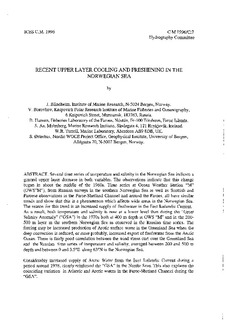| dc.contributor.author | Blindheim, Johan | |
| dc.contributor.author | Østerhus, Svein | |
| dc.contributor.author | Borovkov, Vladimir | |
| dc.contributor.author | Hansen, Bogi | |
| dc.contributor.author | Malmberg, Svend-Aage | |
| dc.contributor.author | Turrell, William R. | |
| dc.date.accessioned | 2012-09-26T14:07:57Z | |
| dc.date.available | 2012-09-26T14:07:57Z | |
| dc.date.issued | 1996 | |
| dc.identifier.citation | This report is not to be cited without prior reference to the authors | no_NO |
| dc.identifier.uri | http://hdl.handle.net/11250/105548 | |
| dc.description.abstract | Several time series of temperature and salinity in the Norwegian Sea indicate a
general upper layer decrease in both variables. The observations indicate that this change
began in about the middle of the 1960s. Time series at Ocean Weather Station "M"
(OWS"M"), from Russian surveys in the southem Norwegian Sea as well as Scottish and
Faroese observations in the Faroe-Shetland Channel and around the Faroes, all have similar
trends and show that this is a phenomenon which affects wide areas in the Norwegian Sea.
The reason for this trend is an increased supply of freshwater in the East Icelandic Current.
As a result, both temperature and salinity is now at a lower level than during the "Great
Salinity Anomaly'' ("GSA") in the 1970s both at 400 m depth at OWS "M" and in the 200-
500 m layer in the southem Norwegian Sea as observed in the Russian time series. The
forcing may be increased production of Arctic surface water in the Greenland Sea when the
deep convection is reduced, or more probably, increased export of freshwater from the Arctic
Ocean. There is fairly good correlation between the wind stress curl over the Greenland Sea
and the Russian time series of temperature and salinity, averaged between 200 and 500 m
depth and between O and 3.5°E along 63°N in the Norwegian Sea.
Considerably increased supply of Arctic Water from the East Icelandic Current during a
period around 1978, clearly reinforced the "GSA" in the Nordic Seas. This also explains the
coinciding variation in Atlantic and Arctic waters in the Faroe-Shetland Channel during the
"GSA". | no_NO |
| dc.language.iso | eng | no_NO |
| dc.publisher | ICES | no_NO |
| dc.relation.ispartofseries | ICES CM Documents;1996/C:7 | |
| dc.subject | hydrography | no_NO |
| dc.subject | hydrografi | no_NO |
| dc.subject | current measurements | no_NO |
| dc.subject | strømmålinger | no_NO |
| dc.title | Recent upper layer cooling and freshening in the Norwegian Sea | no_NO |
| dc.type | Working paper | no_NO |
| dc.subject.nsi | VDP::Mathematics and natural science: 400::Zoology and botany: 480::Marine biology: 497 | no_NO |
| dc.subject.nsi | VDP::Mathematics and natural science: 400::Geosciences: 450::Oceanography: 452 | no_NO |
| dc.source.pagenumber | 12 s. | no_NO |
